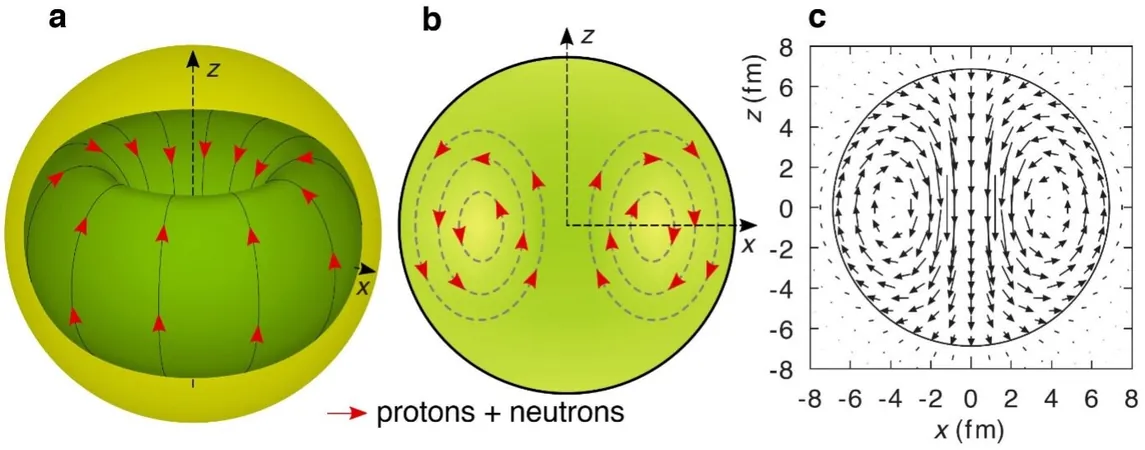
Groundbreaking Discovery: Nickel-58 Nucleus May Reveal Toridal Dipole Excitations!
2025-01-07
Author: Charlotte
Groundbreaking Discovery: Nickel-58 Nucleus May Reveal Toridal Dipole Excitations!
In an exciting development for nuclear physics, researchers have made significant strides in understanding toroidal dipole excitations—unique phenomena that could reshape our understanding of atomic nuclei. These excitations are characterized by a distinctive toroidal distribution of currents, often likened to swirling vortex structures found in nature, such as smoke rings.
Historically, while theories have long suggested the existence of toroidal dipole excitations within atomic nuclei, actual observations have proven elusive. However, a team from Technische Universität Darmstadt, the Joint Institute for Nuclear Research, and other collaborating institutions has become the first to identify potential candidates for these excitations in the nickel-58 nucleus. Their findings, published in the prestigious journal Physical Review Letters, could open the door to further experimental pursuits and deeper insights into the characteristics of heavy nuclei.
Peter von Neumann-Cosel and Valentin O. Nesterenko, co-authors of the study, stated, “Toroidal flow appears in a variety of physics fields, including solid-state physics, metamaterials, and heavy-ion collisions. Just as visible vortex rings can be generated from a puff of smoke, we are now witnessing similar behavior within atomic nuclei.”
Over the past five decades, the existence of toroidal modes has been predicted in nuclear models, with some experimental evidence pointing towards these elusive states. Previous research has evaluated low-energy dipole states using innovative scattering techniques involving photons, electrons, and protons, yet concrete evidence remained hard to find. "We have discovered that some dipole states previously categorized as magnetic dipole (M1) are actually dipole electric (E1) with unusual properties, suggesting they might be toroidal in nature," added von Neumann-Cosel and Nesterenko.
The current study marks a pivotal moment in research by establishing a correlation between theoretical predictions and empirical observations in nickel-58. The use of all three scattering techniques—photon, electron, and proton—has provided robust signatures indicative of toroidal modes.
However, this research extends beyond basic scientific inquiry. Understanding these excitation modes has profound implications on the field of astrophysics, particularly in relation to nucleosynthesis— the process through which heavier elements are formed in stars. The research team has pointed out that in heavy nuclei, where neutrons significantly outnumber protons, a mysterious resonance-like structure of electric dipole strength has been observed at low energies. This structure’s characteristics could dramatically affect theoretical models used to predict the behaviors and interactions of these elements in cosmic settings.
Looking ahead, von Neumann-Cosel and Nesterenko are spearheading new experiments set for 2025 at the S-DALINAC electron accelerator in Darmstadt. They aim to further explore the relationship between low-energy structures and toroidal electric dipole excitations while measuring gamma decay processes to validate their findings.
As we stand at the forefront of this groundbreaking research, the prospects of unveiling the secrets of the universe's heavy elements through the lens of toroidal dipole excitations continue to grow. Stay tuned—the next wave of findings could change the way we understand the fabric of the cosmos!









 Brasil (PT)
Brasil (PT)
 Canada (EN)
Canada (EN)
 Chile (ES)
Chile (ES)
 Česko (CS)
Česko (CS)
 대한민국 (KO)
대한민국 (KO)
 España (ES)
España (ES)
 France (FR)
France (FR)
 Hong Kong (EN)
Hong Kong (EN)
 Italia (IT)
Italia (IT)
 日本 (JA)
日本 (JA)
 Magyarország (HU)
Magyarország (HU)
 Norge (NO)
Norge (NO)
 Polska (PL)
Polska (PL)
 Schweiz (DE)
Schweiz (DE)
 Singapore (EN)
Singapore (EN)
 Sverige (SV)
Sverige (SV)
 Suomi (FI)
Suomi (FI)
 Türkiye (TR)
Türkiye (TR)
 الإمارات العربية المتحدة (AR)
الإمارات العربية المتحدة (AR)